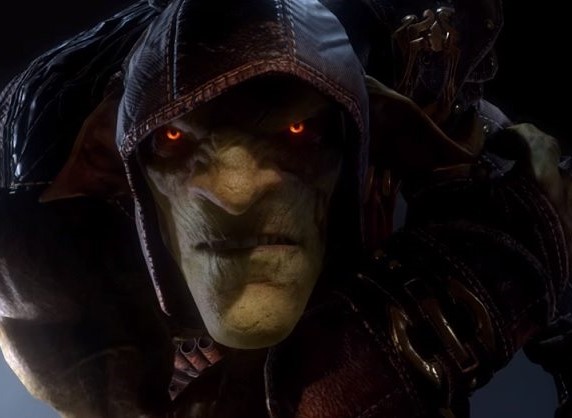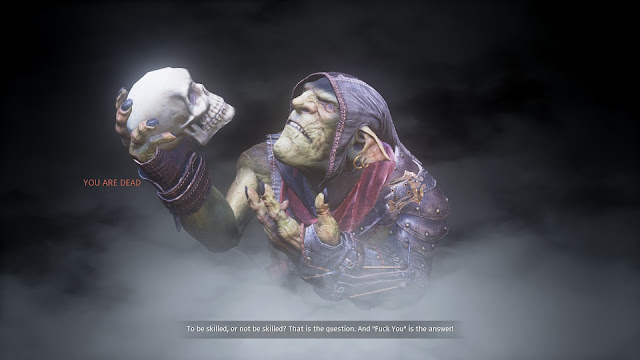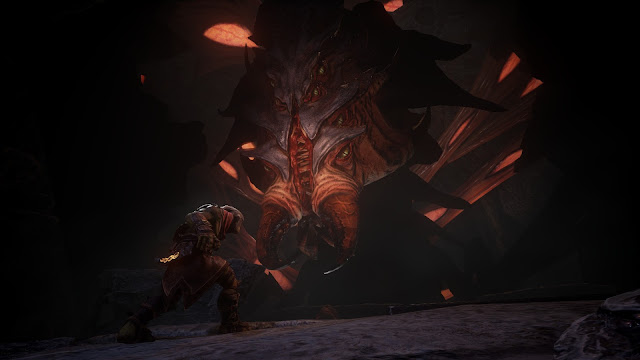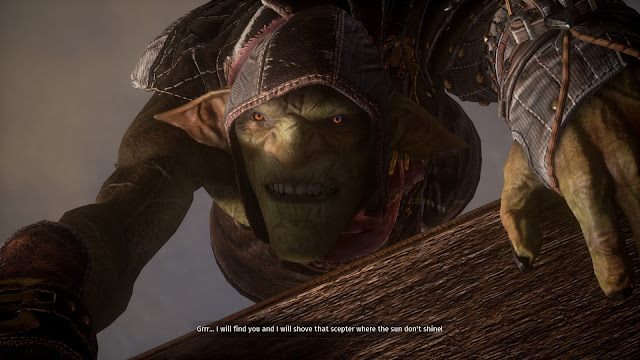Review by Ginny W.
It’s hard to explain the Styx franchise to someone in polite conversation. It’s definitely difficult to explain on a date. Hell, not even my best friend wants to hear about how I spent my weekend walking a mile in the shoes of an ugly goblin who shanks people to death in dark alleyways and swears more than a Gold Coast bogan. It seems like a miracle, but Styx: Shards of Darkness is a uniquely grotesque and refreshingly self-aware offering from Cyanide Studios. Despite the myriad of in-game puns about sticks up the ass, it shows none of that pretentiousness in presentation.
If you’ve watched the launch trailer for Styx: Shards of Darkness then you’re probably drawing some enlightened (or unfortunate) parallels between the titular protagonist and Deadpool. Or Geralt of Rivia. Maybe a schmear of Corvo Attano. I don’t blame you; the game looks like the lovechild of Assassin’s Creed and Shadow of Mordor, and it appears to have the elaborately staged assassinations that were a crowd favourite in Dishonored. However, if you’re a diehard fan of any of the above games then let me be the first to say that to tar Styx with the same brush would be a mistake. This isn’t a stealth game pissing contest. It’s a simple fact – Shards of Darkness is an entirely different beast when it comes to modern stealth games.
If you’re a newcomer to the franchise, then prepare to be in for a world of hurt. Literally. The fact that Styx is a goblin requires players to recalibrate how they would ordinarily view combat, movement, and risk-taking in a game. The humanoid races are the bad guys here, and while you have performance-enhancing substances on your side (amber), their considerable size difference and the fact that most navigable terrain was built for them poses a continual challenge. You’ll be knocked aside, your only option in open combat is to pray that you can get a counterattack off, and you’ll perish if you so much as get clipped by some spiked terrain. Falling what would otherwise be an acceptable distance for a larger creature takes a sixth of your health bar. It’s a bit like the power disparity between Master Chief and a regular Marine, and much like Halo: ODST, it’s a surprisingly nice change of pace. This isn’t a game where you saunter through town camouflaged only by nearby nobles and prostitutes. Being the posterchild for a universally hated race means that the only way to stay safe is as Styx is by sticking to the shadows, and that’s the main difference between Shards of Darkness and most modern games that are touted as “stealth” titles – if you get caught with your pants down here, you’re dead. In these times, stealth isn’t a choice; it’s a way of life.
However, the ol’ hide in a haystack trick isn’t going to cut it. Let me put it this way – Styx smells so bad that you can accidentally blow your cover by getting too close to certain NPCs. He’s difficult to work with, his allegiances shift in the blink of an eye, and all it takes to buy his favour is a hit of whatever mineral is his drug of choice for the week. Cyanide Studios have done a good job of turning a bunch of D&D monster manual stereotypes into traits that impact on the actual mechanics and execution of the game. Enemies have an answer to all of your weaknesses – heavy armor, roaming pets, and sharp noses will all throw the odds further their favour and render the shadows ineffectual cover. Side quests offering immensely valuable items will bring out the greedy gobbo in you, but you’ll be putting potential skill points on the line if you slaughter too many enemies or take too long to find whatever it is that you’re looking for. The already-zany plot ramps up exponentially with each betrayal and in Of Orcs and Men’s dog-eat-dog world (the overall world that this game comes from is based on that now nearly forgotten PlayStation 3 RPG), betrayal is as necessary to life as a hearty breakfast. Styx’s an impulsive, violent lad, and his reactions to the world around him embody that to the fullest, whether it’s a lewd offhand comment or mandating an escape route with an unnecessarily high body count.
While the game has made an admirable attempt to ensure that multiple playstyles are accounted for, maximum stealth is still the most reliable way to get the most points in every level and to ensure that you don’t get disemboweled. The fact that I was on the receiving end of many a one-hit KO around the mid-game ensured that this goblin didn’t deviate from their playstyle once they found out what worked. The best way to navigate a level in Shards of Darkness appears to be a mixture of dynamic stealthing and weaving, and a healthy dose of fervent prayer. There’s very little time to make a rational decision once you catapult yourself onto a platform in near-darkness, only to find an unexpected welcoming party of poisonous insects alerted by the sound of your feet touching the ground. The game stresses the importance of planning ahead, whether it’s memorising escape routes or sensing the location of the nearest heavy object that can be detached from the ceiling for a bloody good time. Additionally, the lack of a map or compass means that the good ol’ days of memorising level layouts and places to hide are in vogue again. While level designs are re-used and players might initially feel stifled, that reaction is really the byproduct of what feels like a decade of open-world games being force-fed to the public. Besides, how large can a level become without inciting unbearable frustration when players are operating without navigational tools? Shards of Darkness repeatedly explores a handful of complex, layered environments, and each time you’re sent back to a zone you’ve already visited feels like another chance to flex your master assassin muscles – for every secret passage that you know like the back of your hand, there’s five more waiting for you to discover.
Now, Styx is undoubtedly the master of stealth and environmental puzzles but he’s in no way the master of stabbing. That might seem ironic given the fact that the main way he kills things is by leaping onto their faces and repeatedly carving off slabs of flesh like Christmas ham, but it’s true. Critics complained that the combat in the last Styx game was clunky, and it pains me to say that while stealthed kills are now performed almost too elegantly, there’s a lot less to love about open combat. Yes, I know that Shards of Darkness is a stealth game and that I just went on about how full stealth is the best way to clear the levels. Yes, I also know that stealthed kills and interactions are heavily incentivised in titles like these but I’m not talking about the core mechanics of the game being a problem here. I’m talking about issues like finicky targeting and hitboxes.
If you’re discovered by more than two enemies who then proceed to run up to you, you’re basically buggered; you can only parry one target at once (which makes sense), but trying to actually get the camera to cooperate and to let you lock onto said target long enough to get the prompt to actually parry is mission impossible sometimes. I have no complaints about the amount of damage taken from enemies, nor am I angry about the fact that encountering a pack of humans means that I’m dead meat. It’s when I’m faced with a single, lightly-armoured human and unable to fight back despite gazing pointedly at the area between his balls and his face that the combat feels decidedly disjointed. Flying assassinations from rooftops? No problem. Silent kills from behind? Easy as pie. Anything else? You’ve got a one in three chance of actually triggering a prompt to parry and most of the time you’ll just get a face full of medieval jorts before an untimely death. In a game that leaves very little up to chance, a crucial element of counterplay being so finicky to trigger feels a bit out of place. Some of this clunkiness translates to vertically navigating terrain, and I’m definitely guilty of leaping in the direction of some overhanging rope but seeing it pass physically through my little green hands because I didn’t quite nail the exact point needed to hold on. However, the game usually turns risky parkour slip-ups into navigation strategy (you can hold down a key to grab onto things while falling), and that in itself adds a different mechanical dimension to the proceedings that amuses even when it mildly infuriates.
Before any novice players out there get disheartened, dying in this game isn’t without its own perks. That is, if you consider being verbally reamed by a snarky goblin a good time. Styx draws the Deadpool association because of its frequent shattering of the fourth wall, and it’s most prominent when you’re dead. Every time Styx dies, he looks you dead in the eye in the subsequent screen and cusses you out for being shit at the game. His insults range from poetic adaptations of Shakespeare to asking you whether or not you’ve gotten the jump button stuck between your ass cheeks. There’s quite a few of these zingers delivered during exploration as well – encounter a labyrinth of a shanty town and you’ll hear the goblin’s familiar gravelly tones remarking on how the place has more holes than a rundown brothel. Styx seems to only think aloud and he makes the player privy to every single one of his calculations, whether it’s reading a flight plan or musing about the odour of human socks. I’d probably have gotten sick of his chattering if not for the fact that each unique environment and associated narrative mission had its own unique observations; the only repetition appeared to be in the death cutscenes and when the player was idle. When you add that to the fact that a fair amount of the talk was shop talk about enemies’ weaknesses, musings about entrances looking familiar, and methods of body disposal, you start to see the ways in which the developers have made up for the lack of overt direction in the game.
Playing Shards of Darkness is about immersing yourself in the role of an assassin who relies not on reading a yellowed map every few minutes but on gleaning information through espionage and making snap judgements at the slightest whiff of danger. Forcing players to have to stop and listen to the environment, enemies, and Styx to figure out what to do might seem overwhelming for the first few missions but it slowly becomes a comfortable, organic process as the plot rolls on. The game is all about layers, whether they be literal in the form of floors in a cave to explore, or metaphorical as the player’s understanding of combat and stealth grows with each return to a familiar setting. There’s layers of wordplay and double entendres, and layers of intrigue when the main players in the narrative are revealed to be bowing to forces greater than they themselves fully understand.
Where Shards of Darkness excels is when it gets you to think dynamically and to pare off all the extraneous technicalities, when hiding and slashing and scheming becomes second nature after you’re forced to hone your skills by being thrown for a loop once you think you know it all. This is a game that you need to sink more than just a handful of hours into in order to really appreciate but in my opinion, the reward is well worth it – the feeling of nailing a multi-target assassination with some high-octane traps before ziplining away and cackling was indescribable, and made much more meaningful by the fact that a few hours ago I was struggling to find my own ass in the dark. Go on, now. Spend seven hours in heaven with everyone’s favourite gobbo and I bet you’ll appreciate every disgusting little inch of him in no time.
– Ginny W.
Contributor











